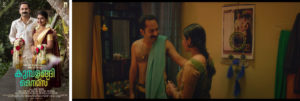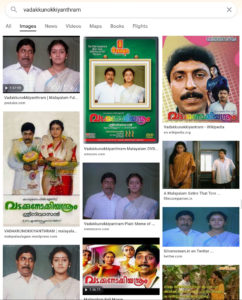S. Harikrishnan writes about how Malayalam cinema uses couple-and-wedding photographs as a useful plot device—to guide narrative, enhance contrast and add depth to characters.
S. Harikrishnan
Between cinema and photography, Roland Barthes famously chose ‘Photography in opposition to the Cinema, from which [he] nonetheless failed to separate it’. To Barthes, this was to do with the temporal distinction between photography and cinema. With the former, a spectator has control over time and circumstance, while in film, this power is ceded to the author. Two years after Barthes’ Camera Lucida was published, Agnès Varda made Ulysse (1983), a documentary where she retraced a photograph she took three decades ago, in search to find its meaning—a ‘punctum’, as Barthes would have called it, or a ‘caption’, as Walter Benjamin describes in his A Short History of Photography (1931). With little luck in finding anything concrete—Varda traces down both the humans in the picture only to find out they have no recollection of the image, and she shows the picture to a goat who eats it—she concludes that ‘nothing appears in the image’, and that the picture itself could have been clicked any other time and the people in it could be anyone else. Her attempt was, as she concedes, to try and find/ascribe meaning both to the photograph, and through it, to her own oeuvre of film-making. It was an attempt at understanding the relation between photography and/in cinema. If we concede that a photograph is given its meaning—its punctum—through a text (caption), how can we begin to think of a cinematic adaptation of this? What can a photograph offer to cinema? I recently happened to revisit this question of the relationship between photography and cinema while watching (and re-watching) some old and new films from Kerala.

The most common use of photographs in cinema tends to dwell on the photograph as a mute and intransigent object from the past, providing disputable/indisputable proof of an event that has occurred. This reading of a photograph as ‘evidence’ is most commonly seen in thrillers, detective movies, and melodramas. When the Chief Minister is assassinated in the classic Malayalam thriller The Truth (1998), the inquiry revolves around a camera and photographs found at the spot of a woman presumed to be the assassin. A photograph, here, is both the evidence—and as we discover eventually—the decoy. Other thrillers like No. 20, Madras Mail (1990), and FIR (1999) also see a similar use of photographs as ‘evidence’. But my interest in this piece is on a very peculiar type of photograph that has made its presence felt in Malayalam cinema—the wedding and/or couple photograph. The wedding photograph has, to borrow Susan Sontag’s phrase, ‘been as much a part of the ceremony as the prescribed verbal formulas’. How, then, are wedding/couple photographs used in cinema to guide narrative?
Just before we are introduced to the brilliant climax of the recently released The Great Indian Kitchen (GIK) comes one of my favourite scenes from the film: a forty-five-second montage of photographs—mostly of married couples—from across generations all hanging on a wall in the house. The sequence cuts from one photograph to another as sounds of banal and everyday kitchen chores play in the background. The sequence ends with a wedding photograph of the unnamed protagonists (played by Nimisha Sajayan and Suraj Venjaramoodu) whose marriage hangs by a thread, and the sound of a ‘whistle’—a literal and metaphorical releasing of (pent-up) steam. This is not the first time their wedding photograph is shown to the audience. It appears thrice in the film before this scene, each time reflecting the changing nature of the marriage itself, as tensions simmer between the couple. The first time, we see it positioned on the wall as the couple have their first fight. By the time it reappears, the tensions have already become much more visible. Here, the photograph hangs on a background wall between the couple, as Suraj confronts his wife for applying for a job without his permission. The third time we see it, the photograph stays in focus as the wife closes a door behind her; differences between them have now become irreconcilable. The last time we see it is as part of the montage, reminding us that it is but another marriage like the many before… almost.

In GIK, the photograph is not merely a mute and intransigent object from the past, but also a constant reminder that the happy couple whose photograph hangs on the wall is starkly different from the couple we see in the film. In this sense, the photograph aims to overstate its difference from the film itself. A similar use of the wedding photograph can be seen in Kumbalangi Nights (2019). One of the film’s early posters was a picture of Shammi (Fahadh Fasil) and Simmy (Grace Anthony) as newlyweds. The wedding itself was never a part of the film plot, but, like in GIK, we see the wedding photograph printed on a calendar that hangs in their bedroom; a happy memory in stark contrast to the aggressive and moralising masculinity of Shammi that unfurls on-screen. Once again, the photograph does more than just freeze a memory in time. It reminds the viewer of the contrast.

In Innale (1990), the climax of the film hinges on photographic evidence of Narendran’s (Suresh Gopi) marriage to Gauri (Shobhana). The film begins with Gauri meeting with an accident that causes her amnesia and resulting in her forgetting her past. She begins a new life as Maya and falls in love with Sarath (Jayaram). Meanwhile, Narendran’s quest for his lost wife brings him to Sarath, who promises to let Gauri leave if Narendran has proof that she is, indeed, his wife. Narendran insists that they would not need a photograph as proof because Gauri would recognize him as soon as she sees him. But when Gauri talks to him with no recollection of the past, Narendran is confronted with a dilemma of whether to bring up a photograph to prove her identity or not. Once again, the photograph becomes a powerful agent upon which the very plot of the film hinges. In a suspenseful scene in the climax, Narendran lays out two photographs on a table, battling with himself about what the right thing to do would be.

In contrast to GIK, Kumbalangi Nights, and Innale, which use the photograph as a reminiscence of the past, Bangalore Days (2014) uses wedding photos to indicate future events. All four main characters from Bangalore Days—Divya (Nazriya Nazim), Krishnan (Nivin Pauly), Arjun (Dulquer Salman), and Das (Fahadh Fazil)—appear on-screen together for the first time for a photograph at Divya and Das’ wedding. In this scene, Das—and along with him, the audience—is given a hint of his upcoming relationship with his wife and her cousins, as he stands awkwardly by himself while Divya, Krishnan, and Arjun get their pictures clicked. Even before a word is spoken, we are given a sneak peek into events to come.

Another film that uses the couple-photograph ingeniously to drive a narrative is Sreenivasan’s Vadakkunokkiyanthram (1989). In what has become the most memorable scene from the film, Dineshan (played brilliantly by Sreenivasan) and his wife Shobha (Parvathy) visit a studio to get their photograph clicked. In the previous scene, Dineshan is convinced by his friend that hanging a photograph of the couple in their bedroom would be a good way for the newlywed wife to ‘see’ him and talk to him while he’s away at work. Dineshan is also told to use as much ‘make-up’ as he needs so he can look as fair as his wife at least in the photograph. This is one of the early scenes from the film when we are introduced to Dineshan’s insecurities and inferiority complex which builds, as the plot progresses, into a severe case of Othello syndrome. Trying to look taller in the photograph, Dineshan moves just as the photograph is being clicked, thereby ruining it. This picture would also become the iconic image from the film that is etched in popular memory (a simple Google search of the film will prove this). Far from its intended purpose of assuaging Dineshan’s insecurities, the photograph becomes a frame that freezes them in time.

Over the last decades, other films like Photographer (2006), 5 Sundarikal (2013), and more recently, Maheshinte Prathikaram (2016) have further explored the theme of photography within cinema directly. Even as the debate on the comparative merits of film and photography rages on, photographs remain useful as film-ic tropes. This is because photographs, as David Campany has written, operate ‘somewhere between fact and fiction, between history and memory, between the objective and the subjective’. This is what makes them a powerful tool at the hands of a film director. It is this artistic freedom that gives a photograph its punctum within a cinematic adaptation.
About the Author: S. Harikrishnan is a postdoctoral researcher at Dublin City University, and a co-editor of Ala.

good – detailed one – close observation
Interesting!
This is a gripping take on couple photographs in Malayalam films! I hope the author might have also noticed the photographs of the dead persons exhibited in the background while presenting a tharavadu/home. What catches my attention is many films use the photographs of actors who are no more; for instance, Sukumaran’s photograph in Nandanam… those actors are never going to appear in the film, still, the spectators might be moved by the legacy they leave behind.
Thanks, Anu. Yes, this is an interesting use of photographs too. I assume it also helps to accentuate a certain character about the deceased person (without their being in the film) that the audience already has, because of the roles played by the actor? It’s an interesting thought. Thanks for the prompt! 🙂
Excellent 👏🏻👌🏻💖